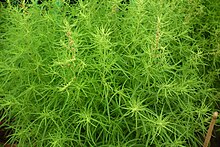Bassia scoparia
| Bassia scoparia | |
|---|---|
 |
|
| Scientific classification | |
| Kingdom: | Plantae |
| (unranked): | Angiosperms |
| (unranked): | Eudicots |
| (unranked): | Core eudicots |
| Order: | Caryophyllales |
| Family: | Amaranthaceae |
| Subfamily: | Camphorosmoideae |
| Genus: | Bassia |
| Species: | B. scoparia |
| Binomial name | |
|
Bassia scoparia (L.) A.J.Scott |
|
| Synonyms | |
|
Kochia scoparia (L.) Schrad. |
|
Kochia scoparia (L.) Schrad.
Bassia scoparia (syn. Kochia scoparia) is a large annual herb in the family Amaranthaceae native to Eurasia. It has been introduced to many parts of North America, where it is found in grassland, prairie, and desert shrub ecosystems. Its common names include burningbush,ragweed, summer cypress,mock-cypress, kochia, belvedere, Mexican firebrush, and Mexican fireweed.
The seed of Bassia scoparia is dispersed by wind and water, and it is transported when the whole plant detaches and rolls on the wind as a tumbleweed. The seed does not persist in the soil seed bank, dying within about a year if it fails to germinate.
The species is a C4 plant, specifically of the NADP-ME type.
This plant is grown as an ornamental for its red fall foliage. It has also been useful in erosion control on denuded soils. It has been suggested as an agent of phytoremediation, because it is a hyperaccumulator of chromium, lead, mercury, selenium, silver, zinc, and uranium. Bassia scoparia contains higher levels of protein and oxalate than most grasses and fodder plants, thus it also serves as a good forage crop for livestock. When grown as ornamental plant, it is a good choice as evergreen foliage plant for landscapes.
In Japan the seeds are used a food garnish called tonburi (?) (Japanese). Because its texture is similar to caviar, it has been called "land caviar", "field caviar", and "mountain caviar". It is a chinmi, or delicacy, in Akita prefecture. The glossy, greenish black seeds are dried, boiled, soaked, and then rubbed by hand to remove the skin.
...
Wikipedia
